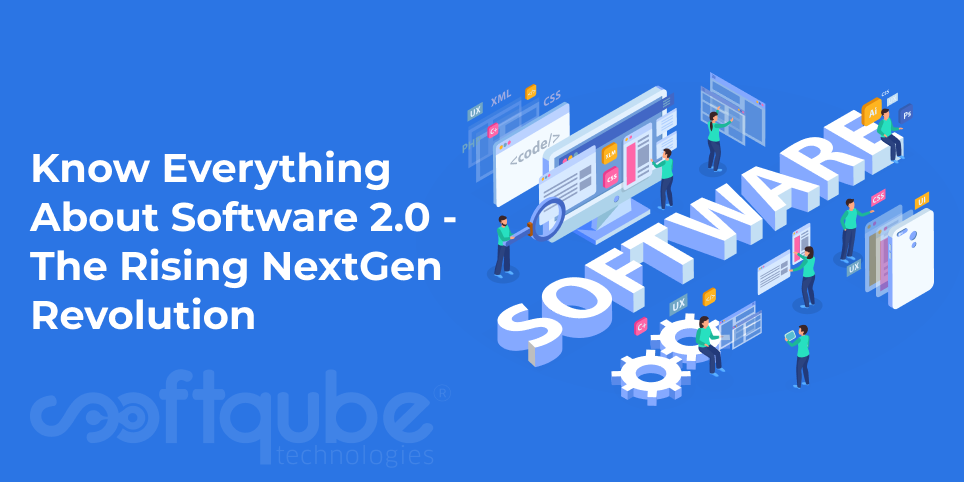Know Everything About Software 2.0 – The Rising NextGen Revolution
April 18, 2022

A decade ago, investors and thinkers believed software is influencing the world. Now, these days the industry foretellers say AI aka Software 2.0 is taking over the place of Software. Looks confusing? Time to spare a few minutes to know what is in for you here
The world is at the helm of watching a profound change in the manner software is developed. From the emergence of computers to writing lines of code for the automation of numerous business operations, the world saw it all. There was a time when coders followed waterfall models for meeting the business requirements. This was the time when humans fed commands to the machines. That era was Software 1.0.
What is Software 2.0?
A quick glance at a decade back, when entrepreneurs started designing applications by automatically generating the code from business requirements. As the Deep Learning concept grew, the tech experts built neural networks that can write software codes automatically with the help of instructions. The technological transition was lengthier but sustainable and impactful. The concept of functional programming began soon by using this neural networks model that was named Software 2.0.
Neural networks are a set of algorithms created to recognize patterns. These networks sense the data by a type of machine perception, labeling, or clustering raw input. They acknowledge patterns such as numerical that are present in vectors, be it sound, text, images, or time series.
Benefits of Software 2.0
Software 2.0 is on the way to changing the way the software is developed. The new tools will directly impact the manner in which software developers do their jobs. Moreover, it will also widen the scope of all the software accomplishments initially. There is a lot of progress that has been already made with unstructured data types like images, video, text, and audio.
The most exciting and frequent use cases in this field are discussed below. They can be portrayed as the real advantages that benefit a lot of users at large.
Content Moderation
AI technology models are being used on a daily basis to filter out the harmful image, video, audio content, and text from user-generated content streams. The advertisers can now recognize, detect, and moderate off-brand or poor quality content, toxic speech in text posts, profanity, and other text in images that are not suitable
Facial Recognition
There are several use cases that are based on finding, comparing, and searching faces and verifying their identity based on the faces. Facial recognition technology is used widely to provide secured access to schools, offices, and airports already.
Predictive Maintenance
Agro businesses, manufacturing enterprises, and airline companies in particular use computer vision technology to save maintenance and inspection costs and to increase the lifespan of the assets. The equipment monitoring, asset planning, maintenance scheduling, and finding the asset efficiency are all well-positioned and ready to watch the significant benefits of Software 2.0.

Some Risks of Software 2.0
There are chances that the software can fail sometimes in unpredictable ways. As we know AI is made out of data. Currently, the quality of the data used in training models is also examined thoroughly. During the times when the datasets consist of millions of observations and parameters, it becomes so important to understand this data. This can turn out to be a challenge. Like the ones explained below
Diversified and Biased Team Expertise
You will need powerful cross-functional teams who can address the risks of AI and ML. The teams need to pour in a variety of expertise starting from security controls, privacy, ethics, compliance, design, and domain. They also must consider the particular group of people who come from diversified social and cultural backgrounds. Here one group may accept the idea while the other group finds it totally unacceptable.
Accuracy of the Model
ML can raise the question of explainability. At times, you do not have an answer to why software behaves in a typical manner. However, explainability is essential. Software 2.0 is used for automating processes that were traditionally executed by people.
Explainability of Model
No one can build an ML system that gives 100% accuracy. Even if you train your system to label your digital assets, there are chances that the system’s decision turns out to be incorrect at times. However, these systems shall definitely make less errors than humans, except that the human errors are forgiven.
Conclusion
The future with Software 2.0 can shape up to become automatic and less human. But this kind of achievement is still a long way off. These neural networks are not silver bullets. As tech experts, we must figure out how to design these AI tools enabling them to work with other solutions.
Some aspects of software development will work and some won’t. However, in a shorter span, Software 2.0 will be the most increasingly prevalent means to get plentiful and cheap data along with powerful algorithms that are going to be difficult to design explicitly.
With Software 2.0, the fundamental shift is driven towards the way to computer interactions and for this newer tools and methodologies are needed. Human resources will need to follow suit so as to ensure that their companies are hiring the right people to keep up the pace with technological progress.
Share on







